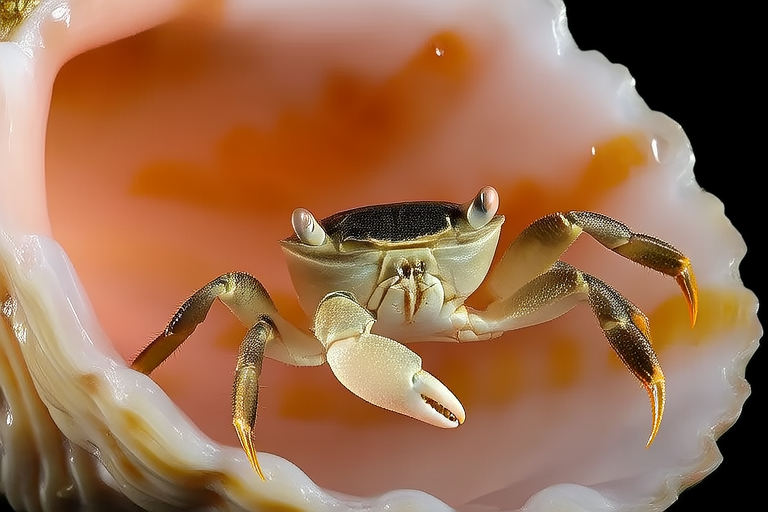Meet the Pea Crab: Nature’s Cozy Houseguest Inside Mollusks
In the vast and diverse world of marine life, there exists a fascinating symbiotic relationship between the pea crab and its mollusk host. This article delves into the unique partnership, exploring the tiny yet significant pea crab and its mollusk home. We will uncover the benefits, lifecycle, and challenges faced by these remarkable creatures, providing an engaging glimpse into the intricate dance of nature.
The Tiny Tenant: An Introduction to Pea Crabs
Pea crabs (Pinnotheridae) are small crustaceans named for their resemblance to a pea in both size and shape. Typically measuring less than an inch long, these delicate creatures possess soft, pliable shells that allow them to fit snugly within their mollusk hosts. Their coloration often mimics that of their host, offering camouflage against predators. Pea crabs have two distinct types of legs: the front pair is modified for feeding, while the rear legs are adapted for swimming.
A Cozy Partnership: The Symbiotic Relationship
The pea crab’s symbiotic relationship with its mollusk host is mutually beneficial. The mollusk provides protection and a steady food supply, while the pea crab reciprocates by cleaning parasites off the host and stimulating the mollusk’s reproductive processes. This dynamic duo thrives in various aquatic environments, including coastal waters, estuaries, and even freshwater habitats.
For instance, when the pea crab feeds on the mucus produced by the mollusk, it helps keep the host clean and free from harmful bacteria. Additionally, the crab’s presence can stimulate the mollusk’s reproduction, increasing the likelihood of successful offspring. This relationship exemplifies the beauty of symbiosis in nature, where both partners benefit from each other’s existence.
The Lifecycle of the Pea Crab Within the Mollusk
The lifecycle of the pea crab begins when a tiny larva, known as a zoea, hatches from an egg. After several molts, the zoea eventually settles near its potential host. Once close enough, the young crab enters the mollusk through the siphon or mantle cavity, taking up residence inside the shell. As the pea crab grows, it undergoes multiple molts, shedding its exoskeleton to accommodate its increasing size. Despite its limited mobility within the host, the pea crab manages to navigate the mollusk’s internal environment, ensuring access to food and safety.
The pea crab remains within its host throughout its entire adult life. Female pea crabs lay their eggs on the gills or inside the mantle cavity of the mollusk. The larvae hatch and are released into the water, beginning the cycle anew. This intimate connection between the pea crab and its host highlights the complexity and specialization of symbiotic relationships in marine ecosystems.
Threats and Challenges Faced by Pea Crabs
Despite the advantages of living within a mollusk, pea crabs face numerous challenges. Predators such as fish and larger crustaceans pose a constant threat to these small creatures. To mitigate this risk, pea crabs rely on their camouflage abilities and the protection provided by their host. However, overfishing and habitat destruction can disrupt this delicate balance, leaving pea crabs vulnerable.
Additionally, environmental changes, such as rising sea temperatures and increased pollution, can negatively impact both the pea crab and its mollusk host. These factors may alter the availability of suitable hosts and reduce the quality of the habitat, making it harder for pea crabs to thrive. Conservation efforts aimed at protecting marine ecosystems are crucial to maintaining the health and stability of these symbiotic relationships.
Fascinating Facts About Pea Crabs and Their Hosts
- Diverse Hosts: Pea crabs can live inside a variety of mollusks, including oysters, clams, scallops, and even certain species of sea cucumbers.
- Gender Differences: Male pea crabs are generally smaller than females and do not share the same level of intimacy with their host. Males often reside outside the mollusk, waiting for mating opportunities.
- Unique Feeding Habits: While inside the mollusk, pea crabs feed on the mucus secreted by the host, detritus, and small organisms found within the host’s environment.
- Evolutionary Adaptations: Over time, pea crabs have developed specialized appendages for gripping the inner surfaces of their host’s shell, ensuring they remain securely in place.
Ecological Significance of the Pea Crab-Mollusk Relationship
The symbiotic relationship between pea crabs and their mollusk hosts plays a vital role in maintaining the health and balance of marine ecosystems. By cleaning parasites and promoting reproduction, pea crabs contribute to the overall well-being of their hosts and, consequently, the broader ecosystem. Moreover, the presence of pea crabs can serve as an indicator of the health of the surrounding environment, offering valuable insights for conservationists and researchers alike.
This unique partnership also highlights the importance of biodiversity and the interconnectedness of marine life. Understanding and protecting these relationships can help ensure the preservation of marine ecosystems for future generations.
Conclusion
The pea crab’s symbiotic relationship with its mollusk host showcases the wonders of nature’s intricate designs. From their tiny size to their complex lifecycle, pea crabs demonstrate the adaptability and resilience of marine life. By learning more about these fascinating creatures and their hosts, we can gain a deeper appreciation for the delicate balance of our oceans and work towards protecting these vital ecosystems.
